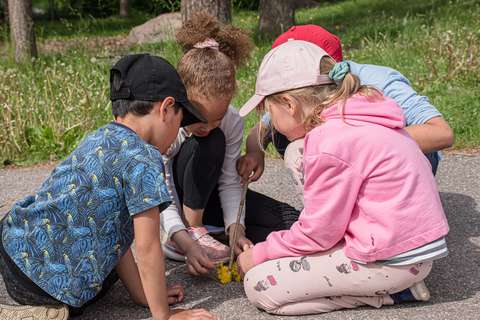Environmental educators and eco support persons promote sustainable early childhood education

Early childhood education in Espoo is guided by the principles of sustainable development. The education activities aim to encourage children to live sustainably. Step by step, a moderate and responsible lifestyle becomes a part of their lives. Such small steps are an immense investment in the future generation of Espoo residents and how our city will be in the future.
Environmental educators and eco support persons in day care centres ensure that education and activities are being carried out in an eco-friendly and environmentally conscious fashion.
These roles may not yet be familiar to many, but they are very significant. Hanne Tikka, teacher, environmental educator and eco support person at Matinkylän päiväkoti, describes her work as follows:
“The eco support persons bring up things that should be taken into account in day care centres’ decisions and purchases. These include purchasing recycling bins, through which it is easy to teach children about waste sorting. Similarly, if a nearby day care centre is shut down, the staff from another day care centre can pick up supplies or furniture from there.”
Tikka also brings up the everyday routines of day care groups: how the group recycles, what they do during trips to the forest, and how their mealtimes go. It is important that best practices are shared with others.
Tiny pollinators
In 2022, the staff and children at Matinkylän päiväkoti talked about pollinators and agreed with the maintenance worker that the lawn will not be mown unless specifically requested. This way, the grass will also have flowers for pollinators. The children also made a couple of small bug hotels which they attached to the fence near the flowers.
Crafts supplies can be recycled
Fortunately, sustainable development is being discussed more and more often, according to Tikka. This makes it a more familiar topic, and both children and adults can come up with new ideas for promoting sustainability. People now know how to buy sustainable materials, and guardians can donate old toys, books, spare clothes and crafts supplies to day care centres.
If most crafts materials come from a reuse centre, for example, it is easy to start pedagogical discussions about the topic with the children. We can tell children why we are doing this, instead of buying the supplies from a shop.
Environmental education in everyday life
Environmental education supports children’s knowledge of and sensitivity to environmental matters. An environmental educator supports children’s understanding of natural processes and how people’s choices influence them. The aim is for them to grow into adults who consume and impact the environment less than previous generations.
“One of the things we teach to children is that one person’s old items can be new for another person, and that things can be borrowed, too. These are small things that ultimately help children understand that buying new things is not always necessary.”
Children’s relationship with nature is supported mainly by going on trips and studying the environment. At Matinkylän päiväkoti, children know on which days they go on trips to the local forest, and they always look forward to it.
If there is something in nature that fascinates the children, the group stops to study it. Children’s interests and questions heavily steer the environmental educator’s work.
Even the youngest children go on the trips. Children aged 1–3 have been particularly interested in ants, for example. Because of this, the group has studied ants and made crafts related to them, viewed them through loupes in nature, and wondered about how they live and how they build their anthills.
“This is a great example of how important it is for an educator to pay attention to the children’s interests. Our job is to inspire children’s play and curiosity.”
Decomposition tests and recycling
The pre-primary education groups start their annual decomposition test in the autumn as children bury different items in the ground. In the spring, they dig the items up and see which have disappeared and which have not. This makes it very concrete for the children to see that you should never litter.
Children are also taught how they can sort waste on their own. The youngest children learn that biowaste always goes into a different bin, while older children learn about more complex sorting.
Once the children move on to basic education and later to upper secondary education, they are more prepared to discuss and come up with ideas for a sustainable lifestyle, together with their teachers and peers.